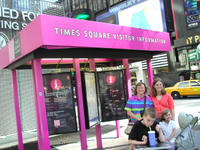A tale of two cities' -- transit that is -- or who needs a ramp out in Hackensack


My wife and I grew up in suburbs just west of Chicago -- Stickney and Berwyn respectively. Consequently, we were used to using public transportation to get around. I can remember going to Wrigley Field as a seventh or eighth grader with a bunch of friends to see a Cubs game, riding the bus and el into Chicago -- no adults needed. This must have been someone else's idea since I, as a south sider, was a Sox fan. My wife commuted to work at Amoco Oil from a couple different transit systems as we moved around the 'burbs.
But now we live in Wisconsin. I would not trade WI for IL ever. I love my adopted state. But we really don't get a lot of opportunities to use public transit, living in a little town built around a quaint lake in an area where you drive -- or walk -- or you stay home. But with this year's vacation taking us to Washington DC and New York City it became clear we should get back on the bus, train and subway. In both locations, we didn't want to spend the big bucks to lodge right in the center of things, opting instead for suburban locations -- Largo, Maryland in the case of Washington and Ridgefield Park, New Jersey in the case of NYC. These were fortunate choices. Both were located within minutes of a transit facilities -- in the case of the hotel we stayed in in Largo within walking distance.
From a standpoint of ease of use for the disabled, the DC Metro subway system was a dream. Every station accessible. Very little gap between the platform and the cars. Roomy, comfortable, cool cars. A big plus for us was friendly and helpful staff who helped us figure out the fare pass system. Everything was as advertised. We did find an elevator out of service at a station we were in, but it was only for maintenance and a workman took another wheelchair user and us up and then continued with his original task. Granted we saw only a limited number of stops in DC, but the Metro system seemed very good for the disabled traveler.
Our experience with New Jersey Transit, by contrast, was more disappointing. I had carefully researched the transit situation in the NYC area. I found which stations were accessible. I made sure to find out how getting on and off trains was supposed to work. I had schedules and timetables. We were ready for NJ Transit. But we distinctly got the impression that NJ Transit wasn't ready for us or anyone using a wheelchair. All of the conductors we encountered really seemed flustered by our son's chair. The accessible stations were supposed to have plates available to bridge the rather large gap between the cars and the platform. In only one case was a plate available, and then it had to be unlocked and carried over. In most cases we just sort of helped Marcus across the gap half rolling and half lifting him across. OK for us, as tourists and one-time visitors. But I had to think there would need to be a lot of educating going on to be a regular traveler on this line in a wheelchair. Doesn't anyone use these trains? If not, maybe I can see why. The caper was on the ride back from the Seacaucus station to our stop at the Essex Street station in Hackensack. The conductor, mild panic in his face, asked us where we were getting off. We said Essex Street. He said "Oh no, we don't have a ramp there." We said there was one, we had used it to get on the train that morning. Then he remembered. I was struck that this conductor didn't know which stations were accessible -- a whole seven out of 16 on this line . I can only assume it doesn't come up that often. That was reinforced by a NJ Transit employee basically ordering people to make room so we could get on. It seemed obvious to me that the people in the handicapped area of the car didn't realize they had to file down the aisles if a wheelchair was to make it onto the car. My first thought -- rude people. But then I thought, you know, I bet they have just never seen this happen before.
Clearly to me there's only one solution. If you find yourself in the position to use the Metro subway system in Washington DC do it. Reward the foresight that designed accessible facilities.
And if you find yourself in a position to use NJ Transit trains, do that too if you can. Hold them to their advertised accessibility. Get them used to customers with disabilities and perhaps it won't come as such a shock next time.





0 Comments:
Post a Comment
<< Home